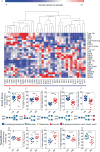A Functional Role for Antibodies in Tuberculosis
- PMID: 27667685
- PMCID: PMC5526202
- DOI: 10.1016/j.cell.2016.08.072
A Functional Role for Antibodies in Tuberculosis
Abstract
While a third of the world carries the burden of tuberculosis, disease control has been hindered by a lack of tools, including a rapid, point-of-care diagnostic and a protective vaccine. In many infectious diseases, antibodies (Abs) are powerful biomarkers and important immune mediators. However, in Mycobacterium tuberculosis (Mtb) infection, a discriminatory or protective role for humoral immunity remains unclear. Using an unbiased antibody profiling approach, we show that individuals with latent tuberculosis infection (Ltb) and active tuberculosis disease (Atb) have distinct Mtb-specific humoral responses, such that Ltb infection is associated with unique Ab Fc functional profiles, selective binding to FcγRIII, and distinct Ab glycosylation patterns. Moreover, compared to Abs from Atb, Abs from Ltb drove enhanced phagolysosomal maturation, inflammasome activation, and, most importantly, macrophage killing of intracellular Mtb. Combined, these data point to a potential role for Fc-mediated Ab effector functions, tuned via differential glycosylation, in Mtb control.
Keywords: Fc-receptors; antibodies; inflammasome; innate immunity; tuberculosis.
Copyright © 2016 Elsevier Inc. All rights reserved.
Figures




Comment in
-
To Be or Not Be a (Functional) Antibody Against TB.Cell. 2016 Oct 6;167(2):306-307. doi: 10.1016/j.cell.2016.09.041. Cell. 2016. PMID: 27716502
-
Antibodies: Marking disease states in tuberculosis.Nat Rev Immunol. 2016 Oct 26;16(11):660. doi: 10.1038/nri.2016.120. Nat Rev Immunol. 2016. PMID: 27782148 No abstract available.
References
Publication types
MeSH terms
Substances
Grants and funding
LinkOut - more resources
Full Text Sources
Other Literature Sources

